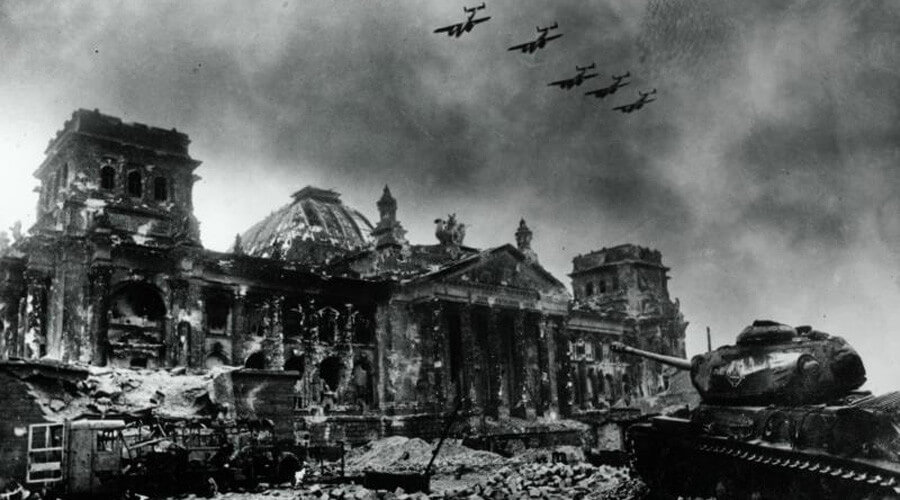
© russiainphoto.ru
Soviet photographer Yevgeny Khaldei never left his camera. He spent 1,418 days photographing heart-breaking moments of WWII. His captivating pictures, including “Raising a Flag over the Reichstag,” were shot on a Leica.
Khaldei created his first camera out of cardboard boxes, making a lens from a pair of old glasses. He was only 13.
His mother and grandfather were killed during the Jewish pogrom in Ukraine in 1918. Still a teen, Khaldei started working at a local plant. After buying himself a decent camera, he started publishing his first amateur images in a local newspaper. Some of the photographs' negatives were sent to Moscow. Finally, in the early 1930s, Khaldei’s pictures were published in the prominent Izvestia newspaper. He then continued his career at TASS news agency as a staff photographer.
Two were the major forces of his work: compassion and terror. Khaldei worked as a recorder of history, creating uncompromising shots in the line of fire.

© russiainphoto.ru
Khaldei pressed the shutter at the peak of action during the Battle for Moscow that lasted from late autumn 1941 to mid-spring 1942. It marked the first major defeat of Nazi Germany in WWII, during the epic Battle of Stalingrad, that became the turning point in the war.

© russiainphoto.ru
The bloody confrontation continued between August 1942 and February 2, 1943, and cost the lives of approximately two million people on both sides. Khaldei traveled with the Soviet Army to participate in the liberation of Romania, Bulgaria, Yugoslavia, Austria, Hungary, and Germany amid fierce fighting.

© russiainphoto.ru
During the Vienna Offensive, a fascist killed Khaldei's entire family at a park and then committed suicide. Soviet General Dmitry Shepilov examined the crime scene together with his soldiers.

© russiainphoto.ru
Vitya Cherevichkin, a Rostov-on-Don resident, was killed by the Germans after they discovered that the teen was hiding pigeons in his barn. Before retreating in 1941, the Nazis commanded the troops to get rid of all pigeons fearing that the birds could be used to transmit secret messages. Cherevichkin had hidden his pigeons for just a week before he was captured for interrogation, accused of complicity with the Red Army, and, then, shot dead.

© russiainphoto.ru
Khaldei's photographs of Hermann Goering, once the second most vigorous man in Germany, at the Nuremberg trials illustrated the face of evil better than 1,000 words. Goering was the one who commanded German Security Police Chief Reinhard Heydrich to organize a “final solution” to the “Jewish question.” Goering, founder of the Gestapo in 1933, was the 2nd-highest-ranking Nazi official tried at Nuremberg. The former Commander of the Luftwaffe and Director of the 4 Year Plan for the German economy, was convicted of war crimes as well as crimes against humanity at the Nuremberg trials.

© russiainphoto.ru
The Austrian capital was bombed fifty-two times in WWII and suffered extensive damage.

© russiainphoto.ru
The shooting of civilians by Nazi troops in February-March 1943. Prison in Rostov-on-Don. Khaldei could barely control his emotions of rage and despair as he photographed corpses, but without his evidence, nobody would have believed that the atrocities of the war had ever occurred.

© russiainphoto.ru
Female fighter pilots of the forty-sixth “Taman” Guards Night Bomber Aviation Regiment enjoying some rare minutes of silence and peace in September 1942. The Nazi used to call these brave women, aged from 17 to 26, Nachthexen (night witches). Over the course of 4 years, these women flew over 24,000 missions, dropped more than 23,000 bombs, and destroyed countless key enemy infrastructure facilities.

© russiainphoto.ru
Khaldei documented the desperate plight of Jews as they were freed from the ghetto of Budapest, with yellow Stars of David glued to their chests, in 1945.

© russiainphoto.ru
Having captured world leaders Joseph Stalin, Winston Churchill, and Harry Truman at the historic Potsdam Conference in 1945, Khaldei also took rare pictures of ordinary people and their everyday lives during the war.

© russiainphoto.ru

© russiainphoto.ru

© russiainphoto.ru
The following picture was Khaldei’s signature shot, “Raising a Flag over the Reichstag”. It's considered symbolic of the Soviet victory over Nazi Germany. Soviet soldiers lifted a hammer-and-sickle flag over the Reichstag on April 30, 1945. However, Khaldei actually took his famous image the day after. When the war photographer reached the site in Berlin, the fighting had already died down, and many flags fluttered at the Reichstag. Still, the photographer had to capture the historic moment. He decided to ask some Soviet soldiers to climb on the Reichstag again, set a sickle-and-hammer flag again, and pose for the image to be taken. Khaldei’s shot entered the history books – although in reality the photo was staged.

© russiainphoto.ru
Reference: RT













Khaldei is such a genius. the one who created a camera at the age of 13 and by just using a pair of old glasses is just mind blowing and even later in life he achieved many goals.
ReplyDeleteWhy is bad graphic design all over the web? This is mainly because business do not want to invest the initial cost in creating a proper web presence or corporate identity. Many companies don't realize how important the two really are.graphic design service
ReplyDelete
ReplyDeleteThese are really amazing and valuable websites you have share with us. Thanks for the informative post. Keep posting like these information.
Graphic design service in chennai
In this article we offer some counsel and thoughts on how you can get the logo plan that you have to speak to your land organization. logo design service
ReplyDelete